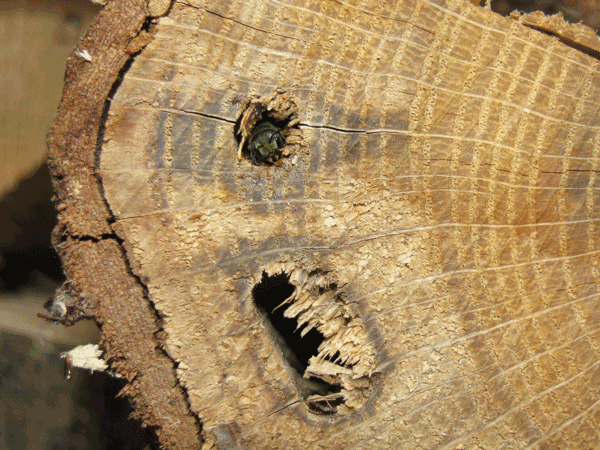You may have come across headlines like “Your Cheap-Ass Bee House Is Probably Killing the Bees” (Gizmodo.com, June 9, 2019), or research showing that bee hotels can be heavily occupied by non-native species (MacIvor and Packer 2015). These critiques have raised valid concerns about the risks of poorly designed or poorly maintained bee hotels. In the end, though, we really don’t have strong evidence for or against bee hotels as a tool for insect conservation.
To reach a conclusion, we would need to know whether bee hotels consistently increase or decrease populations of wild, native bees, compared to a situation where no artificial nesting materials are provided. And we would need to know whether the apparent pitfalls of bee hotels—such as production of parasites or non-native bees—are actually worse in bee hotels than in natural nests.
These are difficult things to measure, and few studies have attempted to do so. One reason is that bee populations vary wildly from year to year. A well-designed, long-term study would be needed to detect effects of bee hotels on overall bee population growth. A few studies in agricultural areas have suggested, but not consistently proved, that wild bee populations do increase when artificial nests are provided over multiple years (Stubbs et al. 1997; Dicks et al. 2010; Roulston and Goodell 2011). Stronger evidence is still needed, especially in urban, suburban, and semi-natural habitats.
In addition, nesting success in bee hotels is difficult to compare to nesting success in natural nests, because natural nests are hard to find. They are often discovered opportunistically, one at a time. And they can be buried in logs and other large objects that make them hard to study in detail (see Figure 55 for an example). Therefore, we don’t really know whether bees nesting in bee hotels are more heavily parasitized, or more likely to catch diseases, than bees living on their own.
Overall, we think that current information still supports—or at least does not discourage—the use of thoughtfully designed and well-maintained bee hotels as habitat enhancements and as a means to appreciate your insect neighbors.
Publication date: July 6, 2022
AG-915
Other Publications in How to Manage a Successful Bee Hotel
- What is a Bee Hotel?
- Meet the Residents
- Bee Hotel Design and Placement
- What If Bee Hotels Aren’t Actually Good for Bees?
- Appendix 1. Bee Hotel Checklist
- Appendix 2. Plants with Leaves and Fibers Used as Construction Materials in the Nest Interior
- Appendix 3. Plants that Produce Hollow or Pithy Twigs and Stems Used by Nesting Bees in Eastern North America
- Appendix 4. Building Plans for a Simple Bee Hotel Shelter
- Appendix 5. Additional Resources
N.C. Cooperative Extension prohibits discrimination and harassment regardless of age, color, disability, family and marital status, gender identity, national origin, political beliefs, race, religion, sex (including pregnancy), sexual orientation and veteran status.

